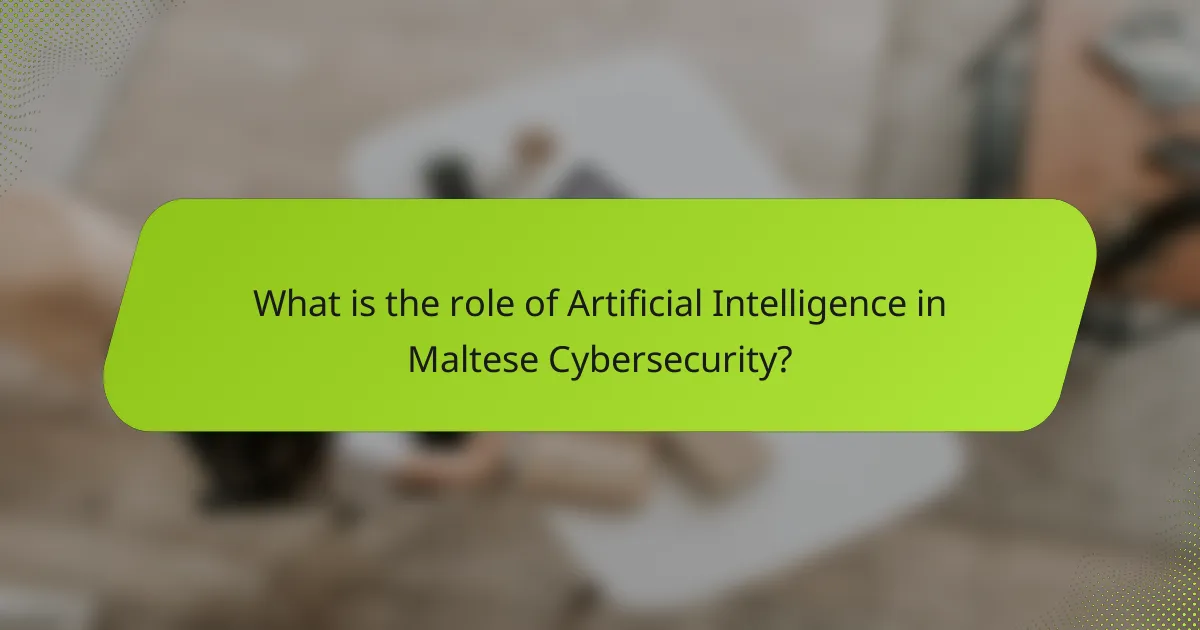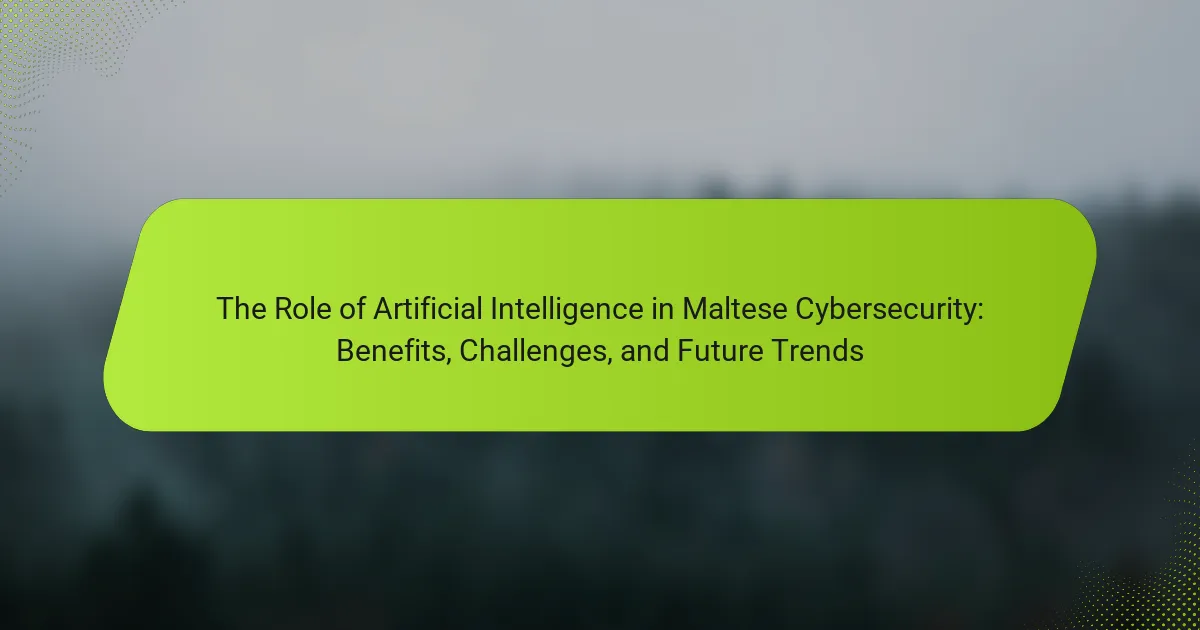
What is the role of Artificial Intelligence in Maltese Cybersecurity?
Artificial Intelligence plays a crucial role in Maltese cybersecurity by enhancing threat detection and response capabilities. AI systems analyze vast amounts of data to identify potential security breaches in real-time. These systems utilize machine learning algorithms to adapt and improve over time. In Malta, AI is employed to protect critical infrastructure and sensitive information from cyber threats. Additionally, AI-driven tools can automate routine security tasks, allowing human experts to focus on complex challenges. The integration of AI in cybersecurity has led to faster incident response times and reduced the impact of cyberattacks. According to a report by the European Union Agency for Cybersecurity, AI technologies can significantly improve the efficiency of cybersecurity operations.
How does Artificial Intelligence enhance cybersecurity in Malta?
Artificial Intelligence enhances cybersecurity in Malta by improving threat detection and response times. AI algorithms analyze vast amounts of data to identify patterns indicative of cyber threats. This capability allows for real-time monitoring of networks, significantly reducing the time to detect breaches. Additionally, AI can automate responses to common threats, minimizing human error. According to a report by the European Union Agency for Cybersecurity, AI-driven tools can reduce incident response times by up to 50%. Furthermore, AI systems can adapt and learn from new threats, making them more effective over time. This continuous learning process is crucial in the evolving landscape of cyber threats in Malta.
What specific AI technologies are being utilized in Maltese cybersecurity?
Machine learning and natural language processing are specific AI technologies utilized in Maltese cybersecurity. Machine learning algorithms analyze vast datasets to identify patterns of cyber threats. They enhance threat detection and response times. Natural language processing is used for analyzing communication data. It helps in identifying phishing attempts and malicious content. These technologies are crucial in improving the overall security infrastructure in Malta. Their implementation has been supported by various local cybersecurity initiatives and collaborations.
How do these technologies improve threat detection and response?
Artificial intelligence technologies enhance threat detection and response through advanced data analysis and automation. They analyze vast amounts of data in real-time, identifying patterns indicative of potential threats. Machine learning algorithms adapt and improve over time, increasing accuracy in threat identification. AI systems can automate responses to detected threats, minimizing human intervention and response time. For example, AI-driven security systems can isolate compromised devices immediately. According to a report by Cybersecurity Ventures, AI can reduce incident response times by up to 90%. These capabilities lead to a more proactive cybersecurity posture, effectively mitigating risks before they escalate.
What are the benefits of integrating Artificial Intelligence into Maltese cybersecurity?
Integrating Artificial Intelligence into Maltese cybersecurity enhances threat detection and response. AI systems can analyze vast amounts of data rapidly. This capability allows for real-time identification of anomalies and potential threats. AI algorithms improve accuracy in distinguishing between legitimate and malicious activities. Additionally, AI reduces the time needed for incident response. Automated responses can mitigate threats before they escalate. The use of AI also supports predictive analytics, forecasting future attacks based on historical data. These benefits collectively strengthen the overall cybersecurity posture in Malta.
How does AI improve the efficiency of cybersecurity operations?
AI enhances the efficiency of cybersecurity operations by automating threat detection and response. It analyzes vast amounts of data quickly, identifying patterns indicative of security breaches. For instance, AI can process network traffic in real-time, flagging anomalies that human analysts might miss. This leads to faster incident response times. According to a report by McKinsey, organizations using AI in cybersecurity can reduce incident response time by up to 60%. AI also improves predictive capabilities, enabling proactive defense measures. Machine learning algorithms adapt to evolving threats, ensuring defenses remain effective. Overall, AI significantly streamlines cybersecurity workflows and enhances overall security posture.
What cost savings can be achieved through AI in cybersecurity?
AI in cybersecurity can achieve significant cost savings by automating threat detection and response. Automation reduces the need for extensive human resources. This leads to decreased labor costs and improved efficiency. AI systems can analyze vast amounts of data faster than human analysts. This speed allows for quicker identification of potential threats. According to a report by Capgemini, organizations using AI in cybersecurity can reduce incident response costs by up to 30%. Additionally, AI can help minimize the financial impact of data breaches by detecting vulnerabilities early. The overall reduction in security incidents translates to lower recovery costs and insurance premiums.
What challenges does Malta face in implementing Artificial Intelligence for cybersecurity?
Malta faces several challenges in implementing Artificial Intelligence for cybersecurity. One major challenge is the lack of skilled professionals in AI and cybersecurity fields. A report from the European Commission indicates that there is a significant skills gap in Malta, which hinders effective deployment of AI technologies. Additionally, regulatory and compliance issues pose obstacles. The General Data Protection Regulation (GDPR) requires strict data handling practices, complicating AI integration. Furthermore, limited funding and resources for research and development in AI also restrict advancements. Finally, the rapid evolution of cyber threats demands continuous updates to AI systems, which can be resource-intensive. These factors collectively impede Malta’s progress in utilizing AI for enhancing cybersecurity.
What are the technical limitations of current AI systems in cybersecurity?
Current AI systems in cybersecurity face several technical limitations. They often struggle with false positives and negatives in threat detection. This leads to unnecessary alerts and missed threats. AI systems also require large datasets for effective learning. Limited access to comprehensive data can hinder their performance. Additionally, AI lacks contextual understanding of complex cyber threats. This can result in inadequate responses to sophisticated attacks. Scalability issues also exist, as AI systems may not adapt well to evolving threats. Lastly, there are challenges related to algorithm transparency and explainability. This makes it difficult for cybersecurity professionals to trust AI decisions.
How does data privacy legislation impact the use of AI in Maltese cybersecurity?
Data privacy legislation significantly impacts the use of AI in Maltese cybersecurity. It sets strict guidelines for data collection, processing, and storage. Compliance with laws like the General Data Protection Regulation (GDPR) is mandatory. This regulation limits how AI systems can access and analyze personal data. Organizations must ensure that AI applications do not infringe on individuals’ privacy rights. Failure to comply can result in hefty fines and legal repercussions. Consequently, this creates a need for AI solutions that prioritize data protection. Businesses are incentivized to adopt privacy-preserving technologies. These technologies include data anonymization and encryption methods. Overall, data privacy legislation shapes the development and deployment of AI in Maltese cybersecurity.
How is the future of Artificial Intelligence in Maltese cybersecurity evolving?
The future of Artificial Intelligence in Maltese cybersecurity is evolving towards greater integration and sophistication. AI technologies are increasingly being utilized to enhance threat detection and response capabilities. Machine learning algorithms are improving the accuracy of identifying potential security breaches. Automated systems are being developed to respond to threats in real-time, reducing response times significantly. Additionally, AI-driven analytics are enabling better predictive capabilities for potential cyber threats. The Maltese government is investing in AI research to bolster national cybersecurity frameworks. Collaboration between private and public sectors is fostering innovation in AI applications for cybersecurity. As cyber threats become more complex, AI will play a crucial role in adapting and strengthening defenses.
What emerging trends are shaping the future of AI in cybersecurity?
Emerging trends shaping the future of AI in cybersecurity include increased automation, enhanced threat detection, and predictive analytics. Automation allows AI systems to manage routine security tasks, reducing human workload. Enhanced threat detection uses machine learning algorithms to identify anomalies in real-time data. Predictive analytics anticipates potential cyber threats by analyzing patterns and trends. Additionally, the integration of AI with blockchain technology increases data integrity and security. The growing use of AI-driven incident response systems improves reaction times to breaches. According to a report by Gartner, AI will significantly reduce response times to security incidents by 2025. These trends indicate a shift towards more proactive and efficient cybersecurity measures.
How can Malta prepare for advancements in AI technology for cybersecurity?
Malta can prepare for advancements in AI technology for cybersecurity by investing in education and training programs. These programs should focus on AI and cybersecurity skills for the workforce. Collaboration between government, academia, and industry is essential. Establishing partnerships can foster innovation and knowledge sharing. Malta should also create regulatory frameworks that support AI integration in cybersecurity. This includes guidelines for ethical AI use. Additionally, investing in AI research and development can enhance local capabilities. Adopting AI-driven cybersecurity tools will improve threat detection and response. According to the European Union Agency for Cybersecurity, AI can significantly enhance cybersecurity measures.
What best practices should be followed for successful AI integration in Maltese cybersecurity?
Successful AI integration in Maltese cybersecurity requires a strategic approach. Organizations should prioritize data quality and relevance. Accurate data enhances AI model performance. Regularly updating algorithms is essential to adapt to evolving threats. Collaboration between cybersecurity experts and AI specialists fosters innovative solutions. Implementing robust training programs for staff ensures effective use of AI tools. Continuous monitoring and evaluation of AI systems help identify weaknesses. Compliance with local and international regulations is crucial for legal and ethical integration. These practices collectively enhance the effectiveness of AI in safeguarding Maltese cybersecurity.
How can organizations ensure compliance with regulations while using AI?
Organizations can ensure compliance with regulations while using AI by implementing robust governance frameworks. These frameworks should include clear policies that align AI practices with existing legal requirements. Regular audits and assessments can help identify compliance gaps. Training employees on regulatory standards is crucial for maintaining awareness. Additionally, organizations should establish data management protocols to protect sensitive information. Collaborating with legal experts can provide guidance on evolving regulations. Utilizing AI tools designed for compliance monitoring can enhance oversight. Continuous monitoring and adaptation to regulatory changes are essential for ongoing compliance.
What strategies can enhance the effectiveness of AI in cybersecurity initiatives?
Integrating machine learning algorithms can enhance the effectiveness of AI in cybersecurity initiatives. These algorithms enable systems to learn from data patterns and improve threat detection over time. Implementing real-time data analytics allows for immediate response to potential threats. Additionally, utilizing threat intelligence feeds can provide context for emerging threats. Collaborating with human analysts combines AI’s speed with human judgment. Regularly updating AI models ensures they adapt to evolving threats. Conducting comprehensive training on diverse datasets enhances AI’s ability to recognize various attack vectors. Finally, establishing clear protocols for AI decision-making increases trust in automated responses.
The main entity of the article is Artificial Intelligence (AI) in the context of Maltese cybersecurity. The article outlines the significant role AI plays in enhancing threat detection and response capabilities, utilizing technologies such as machine learning and natural language processing. It discusses the benefits of AI integration, including improved efficiency, cost savings, and predictive analytics, while also addressing challenges like skill gaps and regulatory compliance. Additionally, emerging trends in AI applications for cybersecurity and best practices for successful implementation are highlighted, providing a comprehensive overview of the current landscape and future developments in Malta’s cybersecurity framework.
